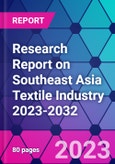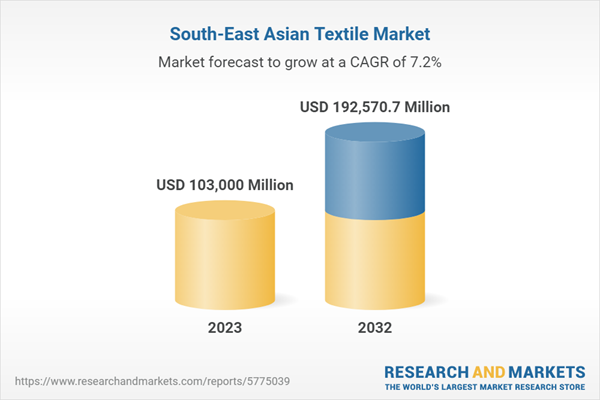According to the publisher's analysis, Southeast Asia has abundant labor resources and lower costs for electricity, land and transportation, which have attracted global textile companies to shift their production capacity to the region. In Vietnam, for example, leading textile company TEXHONG TEXTILE entered the country in 2006, and in 2017, TEXHONG TEXTILE's yarn capacity in the region reached 1.25 million spindles, accounting for 41% of total yarn capacity. In 2021, TEXHONG TEXTILE leased 383,800 square meters of land in Hai Ho Industrial Zone and plans to build a new production base to further expand its capacity in Vietnam. Bros Eastern also laid out in Vietnam in 2013 and has expanded rapidly with tax incentives and low production costs, reaching 1 million spindles of capacity, accounting for 60% of Bros Eastern's total production capacity.
There are some differences in the degree of development of the textile industry in Southeast Asia in different countries. According to the publisher's analysis, countries such as Vietnam have a more developed textile industry, such as Vietnam's textile industry has attracted a large influx of foreign investment, and its production capacity and scale have been rapidly enhanced, with Vietnam's textile exports reaching US$34.646 billion in January-November 2022. According to the Textile and Footwear Industry Development Strategy to 2023 and Outlook 2035, Vietnam plans to reach a total textile and footwear export of US$108 billion by 2030. However, Vietnam's textile industry chain is not yet sound, although the trade surplus of ready-made garments, but fabrics and raw materials, etc. are in deficit, there is still great room for future development.
Southeast Asia in this report includes 10 countries: Singapore, Thailand, Philippines, Malaysia, Indonesia, Vietnam, Myanmar, Brunei, Laos and Cambodia. With a total population of nearly 700 million by the end of 2022, Southeast Asia has an overall economic growth rate higher than the global average and is one of the key drivers of future global economic growth.
According to the publisher's analysis, the economic levels of the 10 Southeast Asian countries vary greatly, with Singapore being the only developed country with a per capita GDP of about US$79,000 in 2022. While Myanmar and Cambodia will have a GDP per capita of less than US$2,000 in 2022. The population and minimum wage levels of each country also vary greatly. Brunei, which has the smallest population, will have a total population of less than 500,000 people in 2022, while Indonesia, which has the largest population, will have a population of about 280 million people in 2022.
The publisher expects the Southeast Asian textile industry to continue to grow from 2023-2032.
Topics Covered
- Southeast Asia Textile Industry Status and Major Sources in 2018-2022
- What is the Impact of COVID-19 on Southeast Asia Textile Industry?
- Which Companies are the Major Players in Southeast Asia Textile Industry Market and What are their Competitive Benchmarks?
- Key Drivers and Market Opportunities in Southeast Asia Textile Industry
- What are the Key Drivers, Challenges, and Opportunities for Southeast Asia Textile Industry during 2023-2032?
- What is the Expected Revenue of Southeast Asia Textile Industry during 2023-2032?
- What are the Strategies Adopted by the Key Players in the Market to Increase Their Market Share in the Industry?
- What are the Competitive Advantages of the Major Players in Southeast Asia Textile Industry Market?
- Which Segment of Southeast Asia Textile Industry is Expected to Dominate the Market in 2032?
- What are the Major Adverse Factors Facing Southeast Asia Textile Industry?
Table of Contents
1 Singapore Textile Industry Analysis1.1 Singapore's Textile Industry Development Environment
1.1.1 Geography
1.1.2 Population
1.1.3 Economy
1.1.4 Minimum Wage in Singapore
1.2 Singapore Textile Industry Operating Conditions 2023-2032
1.2.1 Supply
1.2.2 Demand
1.2.3 Imports and Exports
1.3 Analysis of Major Textile Manufacturing and Trading Companies in Singapore
2 Thailand Textile Industry Analysis
2.1 Development Environment of Thailand Textile Industry
2.1.1 Geography
2.1.2 Population
2.1.3 Economy
2.1.4 Thailand Minimum Wage
2.2 Thailand Textile Industry Operating Conditions 2023-2032
2.2.1 Supply
2.2.2 Demand
2.2.3 Imports and Exports
2.3 Analysis of Major Textile Manufacturers and Traders in Thailand
3 Analysis of Textile Industry in the Philippines
3.1 Philippine Textile Industry Development Environment
3.1.1 Geography
3.1.2 Population
3.1.3 Economy
3.1.4 Minimum Wage in the Philippines
3.2 Philippine Textile Industry Operation 2023-2032
3.2.1 Supply
3.2.2 Demand
3.2.3 Imports and Exports
3.3 Analysis of Major Textile Manufacturing and Trading Companies in the Philippines
4 Malaysia Textile Industry Analysis
4.1 Malaysia Textile Industry Development Environment
4.1.1 Geography
4.1.2 Population
4.1.3 Economy
4.1.4 Minimum Wage in Malaysia
4.2 Malaysia Textile Industry Operation 2023-2032
4.2.1 Supply
4.2.2 Demand
4.2.3 Imports and Exports
4.3 Analysis of Major Textile Manufacturers and Traders in Malaysia
5 Indonesia Textile Industry Analysis
5.1 Indonesia Textile Industry Development Environment
5.1.1 Geography
5.1.2 Population
5.1.3 Economy
5.1.4 Indonesia Minimum Wage
5.2 Indonesia Textile Industry Operation 2023-2032
5.2.1 Supply
5.2.2 Demand
5.2.3 Imports and Exports
5.3 Analysis of Major Textile Manufacturers and Traders in Indonesia
6 Vietnam Textile Industry Analysis
6.1 Vietnam Textile Industry Development Environment
6.1.1 Geography
6.1.2 Population
6.1.3 Economy
6.1.4 Minimum Wage in Vietnam
6.2 Vietnam Textile Industry Operation 2023-2032
6.2.1 Supply
6.2.2 Demand
6.2.3 Import and Export
6.3 Analysis of Major Textile Production and Trading Companies in Vietnam
7 Myanmar Textile Industry Analysis
7.1 Development Environment of Myanmar Textile Industry
7.1.1 Geography
7.1.2 Population
7.1.3 Economy
7.1.4 Myanmar Minimum Wage
7.2 Myanmar Textile Industry Operating Conditions 2023-2032
7.2.1 Supply
7.2.2 Demand
7.2.3 Import and Export
7.3 Analysis of Major Textile Manufacturers and Traders in Myanmar
8 Brunei Textile Industry Analysis
8.1 Brunei Textile Industry Development Environment
8.1.1 Geography
8.1.2 Population
8.1.3 Economy
8.1.4 Brunei Minimum Wage
8.2 Brunei Textile Industry Operation 2023-2032
8.2.1 Supply
8.2.2 Demand
8.2.3 Imports and Exports
8.3 Analysis of Brunei's Major Textile Manufacturers and Traders
9 Analysis of the Textile Industry in Laos
9.1 Development Environment of Textile Industry in Laos
9.1.1 Geography
9.1.2 Population
9.1.3 Economy
9.1.4 Minimum Wage in Laos
9.2 Laos Textile Industry Operating Conditions 2023-2032
9.2.1 Supply
9.2.2 Demand
9.2.3 Imports and Exports
9.3 Analysis of Major Textile Manufacturing and Trading Companies in Laos
10 Analysis of Cambodia's Textile Industry
10.1 Development Environment of Cambodia Textile Industry
10.1.1 Geography
10.1.2 Population
10.1.3 Economy
10.1.4 Minimum Wage in Cambodia
10.2 Cambodia Textile Industry Operating Conditions 2023-2032
10.2.1 Supply
10.2.2 Demand
10.2.3 Import and Export
10.3 Analysis of Major Textile Manufacturing and Trading Companies in Cambodia
11 Southeast Asia Textile Industry Outlook 2023-2032
11.1 Southeast Asia Textile Industry Development Influencing Factors Analysis
11.1.1 Favorable Factors
11.1.2 Unfavorable Factors
11.2 Southeast Asia Textile Industry Supply Analysis 2023-2032
11.3 Southeast Asia Textile Industry Demand Analysis 2023-2032
11.4 Impact of COVID -19 Epidemic on Textile Industry
Methodology
Background research defines the range of products and industries, which proposes the key points of the research. Proper classification will help clients understand the industry and products in the report.
Secondhand material research is a necessary way to push the project into fast progress. The analyst always chooses the data source carefully. Most secondhand data they quote is sourced from an authority in a specific industry or public data source from governments, industrial associations, etc. For some new or niche fields, they also "double-check" data sources and logics before they show them to clients.
Primary research is the key to solve questions, which largely influence the research outputs. The analyst may use methods like mathematics, logical reasoning, scenario thinking, to confirm key data and make the data credible.
The data model is an important analysis method. Calculating through data models with different factors weights can guarantee the outputs objective.
The analyst optimizes the following methods and steps in executing research projects and also forms many special information gathering and processing methods.
1. Analyze the life cycle of the industry to understand the development phase and space.
2. Grasp the key indexes evaluating the market to position clients in the market and formulate development plans
3. Economic, political, social and cultural factors
4. Competitors like a mirror that reflects the overall market and also market differences.
5. Inside and outside the industry, upstream and downstream of the industry chain, show inner competitions
6. Proper estimation of the future is good guidance for strategic planning.

LOADING...
Table Information
| Report Attribute | Details |
|---|---|
| No. of Pages | 80 |
| Published | April 2023 |
| Forecast Period | 2023 - 2032 |
| Estimated Market Value ( USD | $ 103000 Million |
| Forecasted Market Value ( USD | $ 192570.7 Million |
| Compound Annual Growth Rate | 7.2% |
| Regions Covered | Asia Pacific |









